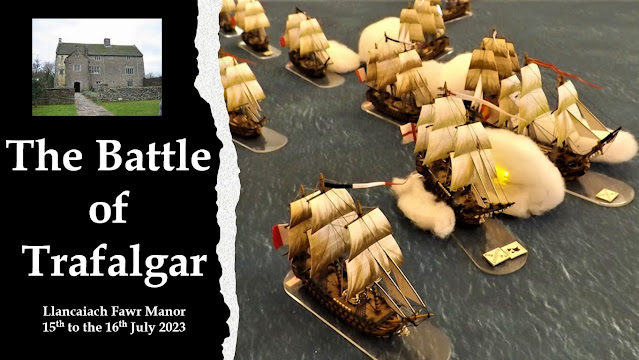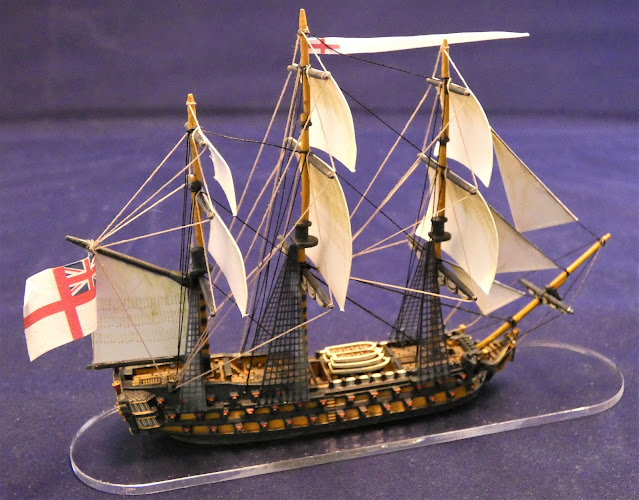This month, I will be taking the All at Sea collection to Wales, and precisely the historic 16th century Llancaiach Fawr Manor in Nelson, very aptly named in this case and about thirty minutes away from Cardiff, where I will be joining with friends from the Devon Wargames Group and the Penarth & District Wargames Society to play a two day refight of the Battle of Trafalgar using Kiss Me Hardy!
 |
| https://www.llancaiachfawr.co.uk/en/ |
We will have all the ships that were present on the day of battle out on the table and will be happy to meet up with visitors to the manor who might like to come and see the game.
In preparation for all the fun, I was keen to incorporate two of the more recently released models from Warlord Games that I picked up last year before I went off on my travels, both bearing the names of the famous ships they represent and both present in the opposing lines of the British and Combined fleets
Originally I had incorporated one of the Spanish generic first rates into my collection to represent the flagship of Vice-admiral Alava as covered in my post from July 2020 - link below.
 |
| JJ's Wargames- All at Sea, Spanish Builds, Part Two |
Since then, Warlord have released a specific model to represent the Santa Anna and I present her here for the first time complete with her vice-admiral's pennant flown from the foremast and with Santa Anna emblazoned across her stern galleries.
Needing 250 men on her capstans to lift her mighty anchors, Santa Anna had an over-strength compliment of 1,189 crew consisting of 720 naval personnel, 383 army and 86 marine artillerymen.
The ship record card is how Santa Anna will be represented in our game, with a crew rating of Poor Landlubbers reflecting the large amount of landsmen and soldiers needed to crew this large first rate to enable her to join the fleet but doing nothing to improve the overall effectiveness of this ship to manoeuvre and fight in battle.
Hence Santa Anna loses one die from her twelve allotted broadside (Kiss Me Hardy - KMH, appears to award a vessel approximately one die per hundred pounds of broadside weight in shot) after her first broadside representing her poorly trained crew, with that lack of training and cohesion affecting her boarding capability, with one less die for 'Poor Crew', and her 'Cowardly Lubber' rating cancelling out the extra 15% added to her morale rating for being Vice-admiral Alava's flagship.
 |
| Vice-admiral Ignacio Maria de Alava |
That said the Santa Anna is still a mighty 2,112 ton first rate with timbers well able to give her a fighting chance as represented by her hull rating of 92 'Damage Point' boxes (again KMH hull size in damage points can be roughly calculated by dividing the displacement tonnage BM by the builders formula of 23.1 to give you a figure in Damage Points) of which she can afford to lose thirteen and still have no effect on her basic morale and the guns she carries allows her crew to dish out twelve dice in her first round of firing and eleven on subsequent rounds, damage received depending.
Alava's flagship is likely to be involved in the thick of the fighting as she was the target of vice-admiral Collingwood's Royal Sovereign attacking the rear of the Combined fleet and is likely to need all of her 92 Damage Point boxes to keep her in the fight with the British first rate.
 |
| The Royal Sovereign depicted bearing down on the Santa Anna ahead - Stuart Bolton |
It will be great to see this new addition to the collection out on the table and getting her first taste of table-top action, and I hope she performs to her best.
The other addition to the collection is HMS Agamemnon, 'Nelson's favourite ship', and affectionately known as the HMS 'Eggs and Bacon'.
As with the Santa Anna my original version of Agamemnon had relied on my efforts to scratch build a 64-gun third rate from the original generic plastic 74-gunner as covered in my post from December 2020, see link below.
 |
| JJ's Wargames- All at Sea, Conversion Work, Part Two, 64-gun Third Rate |
The new Warlord resin hulled 64-gun third rates and this specific named Agamemnon model makes my additional scratch builds useful add-ons to these newer kits.
 |
| HMS Agamemnon as depicted by Geoff Hunt |
Built at Buckler's Hard in 1781, Agamemnon had seen twenty-four years service by the time of Trafalgar, and during his time in command Nelson regarded her;
'. . . without exception as the finest 64 in the service'
Under Nelson's command Agamemnon would be part of Vice-admiral Hood's fleet that took control of the naval dockyard in Toulon, sailing to Naples to pick up Neapolitan troops to occupy the citadel, before it fell to French republican troops.
On the 22nd October 1793, Agamemnon was in action with the 44-gun French frigate Melpomene off the coast of northern Sardinia badly damaging the French frigate after a chase that saw her escape under the cover of friendly escorts having caused slight damage to the British 64.
Nelson's ship would be in the thick of the action over the next three years, providing landing forces and guns to operations in Corsica and against the town of Calvi.
In 1794 she was now part of Vice-admiral William Hotham's fleet, taking part in the battle of Genoa in March 1795, later playing a key role in the pursuit and capture of the damaged French 80-gun ship, Ca Ira.
 |
| Agamemnon opens fire on the Ca Ira - Geoff Hunt |
Agamemnon and Nelson would be reunited in Copenhagen as part of his squadron for the attack on the Danish line, although due to navigational difficulties among the shoals was unable to play a key role.
At Trafalgar the Agamemnon was under the command of Sir Edward Berry an original member of the Nelsonian 'Band of Brothers', the captains in Nelson's fleet that won the dramatic victory at the Battle of the Nile on August 1st 1798.
 |
| Captain Sir Edward Berry commanding Agamemnon at the Battle of Trafalgar. |
He would move to HMS Vanguard 74-guns as Nelson's flag-captain, again at Nelson's request, and was next to the admiral when he was wounded at the Battle of the Nile, but was later captured on HMS Leander 50-guns carrying Nelson's victory dispatches after getting into action with the French 74-gun Genereux, one of the few French ships that escaped the Battle of the Nile.
He was exchanged three months later and arrived in England in 1798 to be knighted and given the freedom of the City of London.
Berry and the Agamemnon joined Nelson's fleet on the 13th October 1805, just in time for Trafalgar, provoking Nelson to remark;
'Here comes Berry! Now we will have a battle!'
The reference Nelson was making was regards to the fact that at the time Sir Edward Berry had been involved in more fleet actions than any other captain.
Additionally with her years of service from the start of the French Revolutionary War, her crew have reached a high level of training and experience, and under the veteran leadership of Captain Berry, more than making her eligible to be rated as Elite Jolly Jack Tars that increases her broadside potential to ten dice on the first round of firing and at any range under short, perfect for getting in close and preferably delivering a passing stern rake which would see those dice doubled to twenty hitting on three or more.
I have to say, I really enjoy working with these new resin hull models from Warlord and their inclusion of the plastic third-rates masts and bowsprit together with the ships boats allows for a very nice model to be built and as with Santa Anna, I'm looking forward to seeing Agamemnon take her place in the line of battle.
 |
| Fleet review back in 2020 of the Trafalgar collection which will be out in force next weekend |
Next up, I've got some other new models to show that will fill some very important gaps in my small ship actions line ups.
More anon
JJ



















Very informative post as always. I run KMH games in the US with Lard America and I will be running a game at Historicon next week. I have been using the standard KMH (or TCG) rules and have noted and have noted that you have made some modifications and improvements. What caught my eye on this post was the way you calculate DP and gunnery dice. I am curious whether you would share your KMH modifications? I also think your ship chart is an improvement over the old one. Thank you! Cheers
ReplyDeleteHi Eric,
DeleteThank you, glad you enjoyed the read.
Yes I have been messing about with the original KMH as, since their first publication a while back, a lot of stuff has been created around them and published in the Specials in the intervening years.
I have now re-written the whole ruleset into a PDF with a searchable index, that we use in the club and brings together all the additions from the Specials plus a few house rules I've added and incorporating my own ship records that I am using for all my games and have prepared around the historical vessels.
This weekend I'm in Wales with the DWG chaps and the Penarth club to play Trafalgar over two days and all the record cards are prepared and laminated for such an occasion.
So the quotes around gun factors and damage point boxes are based on the excellent work by your fellow countryman, Brian Weathersby, who I had the happy occasion of saying hello to on TMP and thanking him for his efforts.
The article you want is entitled 'Messing about with Boats' and was published in the 2011 Christmas Special. Brian also looks at the game scale for KMH which proved invaluable to my using the rules as published for 1:700 as he calculates they workout at about 1:900.
Interestingly I have been studying his comments on timescale which he calculated at about two minute moves based on the infantry movements for landing operations, however I think that might need flexing as Nick doesn't include wind velocity in the rules which means that the time scale is different in light winds to strong ones and the ships would likely cover the same distance much more quickly in the latter case.
On my own calculations I reckon a time scale of five minutes per move is more likely in normal conditions, four minutes in light winds and six minutes for 'Getting Choppy' weather, and I intend too try this scaling out this weekend to see if we can marry the table action moves per hour to the five hours of actual historical battle - what fun!
Anyway I hope that helps and have a great time with Lard America at Historicon. I must make time to do a US Con at some time.
All the best
JJ
Thanks for your response. I did find Brian's article and will use his calculations in my upcoming game. Every so often Nick threatens to work on a KMH v2. I am hopeful but the WWII stuff seems to always get in the way lol. Looking forward to your AAR post on the Trafalgar weekend! Looks to be smashing!
Delete